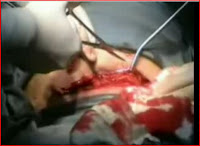From Reuters Health Information
Compared with double-layer uterine closure, single-layer closure following caesarean section doubles the risk of uterine rupture during a subsequent trial of labor, Canadian investigators report in the July issue of Obstetrics and Gynecology.
The researchers therefore recommend that "single-layer closure be reserved for women undergoing tubal ligation or those who require very expedient closure of the uterus." There is no consensus on the best way to close the uterus after c-section, the authors note. Single-layer closure has gained popularity because it shortens operative time and needs fewer hemostatic sutures.
Dr. Emmanuel Bujold, from Universite Laval, Quebec, and colleagues conducted a case-control study among women who underwent a trial of labor following a prior single, low-transverse cesarean delivery. Patients were selected from deliveries at nine centers in the Montreal area between 1992 and 2002.
The analysis included 96 cases of uterine rupture matched to 288 controls by time period and hospital. Rates of single-layer closure were 36% and 20% in the two groups, respectively,
"In multivariable analysis, single-layer closure (odds ratio 2.69) and birth weight greater than 3,500 g (OR 2.03) were linked with increased rates of uterine rupture, whereas prior vaginal birth was a protective factor (OR 0.47)," the team reports. All ORs were statistically significant. On the other hand, suture material had nothing to do with outcomes.
Dr. Bujold and associates say it's possible that a single, continuous suture technique does not approximate the tissues precisely together, and they suggest that single-layer closure leaves a thinner or weaker scar more prone to rupture.
Obstet Gynecol 2010;116:43-50.
